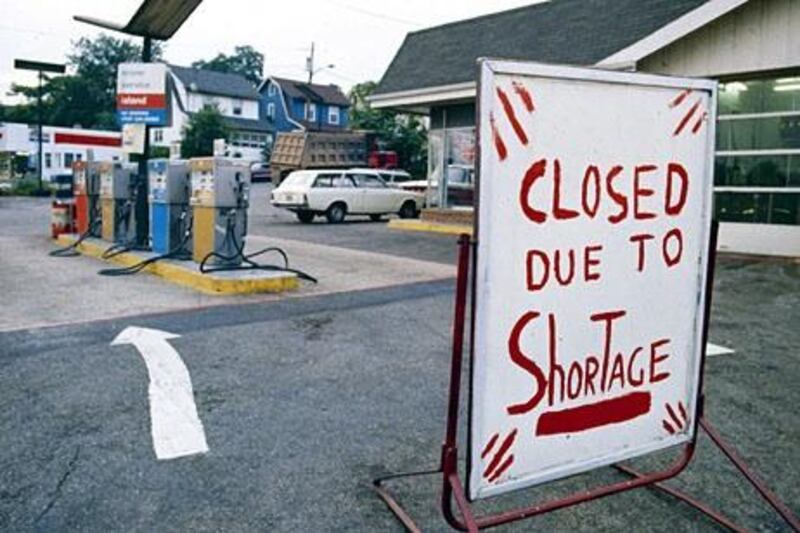The standard view of the 2007-09 crash and recession focuses on excess leverage by banks and governments. Many of the received views on the issue conclude that United States and European growth must stay subdued for a while as the wounds of financial insobriety heal.
However, many have overlooked the role of the oil price explosion after 2005 in exacerbating and even causing the crisis. In the latter half of the 2000s, the world experienced an unexpected energy shortage, as oil demand rose significantly, driven by the rapid expansion of Asian economies. A worldwide economic slowdown was inevitable to reduce oil demand.
Before exploring this further, it would be instructive to look at historical fluctuations in oil prices since the 1950s and their global economic impact.
Between the 1950s and 1960s, oil prices were in a declining trend. Cheap oil provided crucial support to the rapid economic growth enjoyed by the world's most powerful countries at the time, supporting an equity bull market that lasted two decades until the late 1960s.
However, after 1970, geopolitical events led to two major price shocks. In late 1973, the oil embargo imposed by some Opec members following a conflict in the Middle East propelled prices to about US$58 in today's prices. This reflected a fundamental shift in power from oil-consuming to oil-producing nations.
In 1979, a second price shock associated with the Iranian revolution triggered a price surge to about $107 per barrel in real terms.
These two price shocks led to a decisive improvement in energy efficiency in Organisation for Economic Cooperation and Development (OECD) countries on the back of government measures and market responses. Energy conservation allowed economic growth to resume without generating a corresponding rise in oil demand.
At the same time, oil output was boosted by increased exploration and development. All this led to real oil prices falling into a $20-$40 band (at today's prices), a trend that lasted for about two decades. This long period of broad oil price stability was good for global financial assets supporting bull markets in both equities and bonds, as it allowed a progressive decline in inflation as well as sustained economic growth.
By 1998, however, the demand scenario started changing markedly, primarily led by the extraordinary rise in China's oil consumption. Demand grew from 4.2 million barrels of oil per day (bpd) to 7.9 million bpd in 2008. Over the same period, US oil demand also grew 18.9 million to 19.5 million bpd. Total oil demand rose about 16 per cent, from 74.1 million to 85.8 million bpd.
However, energy demand in most countries continued as if the low oil prices over more than two decades were set to stay. On the supply side, producers were reluctant to invest in new production, remembering the glut from two decades before.
The reality that unfolded in 2008 was different. As demand increased, oil prices rose. High-cost reserve supplies were brought on stream to help dampen the price increase, but supply remained constrained. All this cumulatively led to the world being confronted with a chronic oil shortage in 2008.
To reduce oil demand, a worldwide slowdown was needed, and that is exactly what happened. After the financial crisis began in earnest, credit and trade contracted rapidly. By early 2009, the OECD countries entered the deepest recession since the Second World War, resulting in oil demand falling sharply and oil prices collapsing. With their credit systems imploding, western policymakers turned to fiscal policy for stimulus.
By contrast, as exports declined, China announced a major fiscal expansion at the end of 2008. The effect was dramatic: within a few months, growth rebounded strongly, resulting in a rapid rebound in China's oil demand, which by late 2009 was growing strongly again. Oil prices responded.
Although financial forces and government austerity measures have been largely considered responsible for reduced output in the US and Europe since 2009, the economic impact of a tripling of oil prices cannot be ignored.
Higher oil prices tend to reduce domestic spending as incomes are diverted into payments for oil. They also have a significant impact on economic productivity. .
Nevertheless, economic structures are capable of adaptation. Buildings, for example, can be built with natural cooling, new energy-efficient cars can be developed, and smarter software that uses less server power can be created. And, of course we can search for new sources of energy. Shale gas is the key example.
We have now had high oil prices for about five years and quite a lot has been done to make production more fuel-efficient.
The current era of high oil prices and the new technologies and energy sources it is spawning will change the world energy map beyond recognition in the next decade. Some East African countries such as Tanzania will undergo an oil and gas boom, for example. Brazil may be able to finance the next phase of its development. Cyprus and perhaps even Greece may eventually be able to repay all their debts.
As investors, we should look beyond the financial crisis and focus instead on the way the current period of high energy prices is changing our economies.
The focus can be on opportunities for investment in energy, while being aware that the pendulum will swing back once again at some point to an era of lower energy costs with a whole new set of opportunities.
The author is the head of research for private banking and asset management at Credit Suisse





